Influence of Population Density on CO2 Emissions Eliminating the Influence of Climate
Abstract
:1. Introduction
2. Literature Review
3. Materials and Methods
3.1. Population Density of Cities
3.2. Classification of Cities by Population Density
3.3. Electric and Thermal Energy Consumption
3.4. CO2 Emissions
3.5. Elimination of Climate Influence
4. Practical Application
4.1. Classification of Spanish Cities
4.2. Thermal and Electric Energy Consumption
4.3. CO2 Emissions
4.4. Elimination of Climate Influence
5. Results and Discussion
5.1. Sample of Study
5.2. Energy Consumptions per Household
5.3. Energy Consumptions per Inhabitant
5.4. Energy Consumptions per Household without the Influence of Climate
5.5. Energy Consumptions per Inhabitant without the Influence of Climate
5.6. CO2 Emissions
5.7. CO2 Emissions without the Influence of Climate
6. Conclusions
Author Contributions
Funding
Institutional Review Board Statement
Informed Consent Statement
Data Availability Statement
Acknowledgments
Conflicts of Interest
References
- Department of Economic and Social Affairs. 2014 Demographic Yearbook, 64th ed.; United Nations: New York, NY, USA, 2015. [Google Scholar]
- Committed to local sustainable energy. In Reducing Energy Dependence in European Cities; Covenant of Mayors: Brussels, Belgium, 2018.
- European Parliament News. Available online: https://www.europarl.europa.eu/news/en/headlines/society/20180301STO98928/greenhouse-gas-emissions-bycountry-and-sector-infographic (accessed on 12 October 2020).
- International Energy Agency. 2018 Global Status Report: Towards A Zero-Emission, Efficient and Resilient Buildings and Construction Sector; United Nations Environment Programme: Paris, France, 2018. [Google Scholar]
- Shahrokni, H.; Levihn, F.; Brndt, N. Big meter data analysis of the energy efficiency potential in Stockholm’s building stock. Energy Build 2014, 78, 153–164. [Google Scholar] [CrossRef]
- Yan, Y.; Pan, A.; Wu, C.; Gui, S. Factors influencing indirect carbon emission of residential consumption in China: A case of Liaoning province. Sustainability 2021, 11, 4414. [Google Scholar] [CrossRef] [Green Version]
- Department of Economic and Social Affairs. Report of the Inter-Agency and Expert Group on Sustainable—Development Goals Indicators (E/CN.3/2016/2/Rev.1); United Nations: New York, NY, USA, 2016. [Google Scholar]
- European Parliament News. Available online: https://www.europarl.europa.eu/news/en/headlines/society/20200618STO81513/green-deal-key-to-a-climate-neutral-and-sustainable-eu (accessed on 25 July 2020).
- European Commission. A New Circular Economy Action Plan for A Cleaner and More Competitive Europe; COM(2020) 98 Final (2020); European Commission: Brussels, Belgium, 2020. [Google Scholar]
- Energy-Cities. Available online: https://energy-cities.eu/project/covenant-of-mayors-for-climate-energy/#:~:text=The%20Covenant%20of%20Mayors%20gathers,and%20affordable%20energy%20to%20all (accessed on 13 May 2020).
- Jiang, L.; Xing, R.; Chen, X.; Xue, B. A survey-based investigation of greenhouse gas and pollutant emissions from household energy consumption in the Qinghai-Tibet Plateau of China. Energy Build 2021, 235, 110753. [Google Scholar] [CrossRef]
- Zarco-Soto, I.M.; Zarco-Periñán, P.J.; Sánchez-Durán, R. Influence of cities population size on their energy consumption and CO2 emissions: The case of Spain. Environ. Sci. Pollut. Res. 2021, 28, 28146–28147. [Google Scholar] [CrossRef]
- Huo, T.; Ren, H.; Cai, W. Estimating urban residential building-related energy consumption and energy intensity in China based on improved building stock turnover model. Sci. Total Environ. 2019, 650, 427–437. [Google Scholar] [CrossRef] [PubMed]
- Urquizo, J.; Calderón, C.; James, P. Metrics of urban morphology and their impact on energy consumption: A case study in the United Kingdom. Energy Res. Soc. Sci. 2017, 32, 193–206. [Google Scholar] [CrossRef]
- Bart, I.L. Urban sprawl and climate change: A statistical exploration of cause and effect, with policy options for the EU. Land Use Policy 2010, 27, 283–292. [Google Scholar] [CrossRef]
- Nageli, C.; Camarasa, C.; Jakob, M.; Catenazzi, G.; Ostermeyer, Y. Synthetic building stocks as a way to assess the energy demand and greenhouse gas emissions of national building stocks. Energy Build. 2018, 173, 443–460. [Google Scholar] [CrossRef]
- Paravantis, J.A.; Tasios, P.D.; Dourmas, V.; Andreakos, G.; Velaoras, K.; Kontoulis, N.; Mihalakakou, P. A regression analysis of the carbon footprint of megacities. Sustainability 2021, 13, 1379. [Google Scholar] [CrossRef]
- Ali, K.A.; Ahmad, M.I.; Yusup, Y. Issues, impacts, and mitigations of carbon dioxide emissions in the building sector. Sustainability 2020, 12, 7427. [Google Scholar] [CrossRef]
- Pérez-García, J.; Moral-Carcedo, J. Analysis and long term forecasting of electricity demand through a decomposition model: A case study for Spain. Energy 2016, 97, 127–143. [Google Scholar] [CrossRef]
- Szoplik, J. Forecasting of natural gas consumption with artificial neural networks. Energy 2015, 85, 208–220. [Google Scholar] [CrossRef]
- Bianco, V.; Marchitto, A.; Scarpa, F.; Tagliafico, L.A. Forecasting energy consumption in the EU residential sector. Int. J. Environ. Res. Public Health 2020, 17, 2259. [Google Scholar] [CrossRef] [Green Version]
- Salim, R.A.; Shafiei, S. Urbanization and renewable and non-renewable energy consumption in OECD countries: An empirical analysis. Econ. Model. 2014, 38, 581–591. [Google Scholar] [CrossRef] [Green Version]
- Chen, Z.; Zhou, M. Urbanization and energy intensity: Evidence from the institutional threshold effect. Environ. Sci. Pollut. Res. 2021, 28, 11142–11157. [Google Scholar] [CrossRef] [PubMed]
- Greca, P.; Barbarossa, L.; Ignaccolo, M.; Inturri, G.; Martinico, F. The density dilemma. A proposal for introducing Smart growth principles in a sprawling settlement within Catania Metropolitan Area. Cities 2011, 28, 527–535. [Google Scholar] [CrossRef]
- Rahman, M.M. Exploring the effects of economic growth, population density and international trade on energy consumption and environmental quality in India. Int. J. Energy Sect. Manag. 2020, 14, 1177–1203. [Google Scholar] [CrossRef]
- Ali, W.; Abdullah, A.; Azam, M. The dynamic relationship between structural change and CO2 emissions in Malaysia: A cointegrating approach. Environ. Sci. Pollut. Res. 2017, 24, 12723–12739. [Google Scholar] [CrossRef]
- Ali, S.S.S.; Razman, M.R.; Awang, A.; Asyraf, M.R.M.; Ishak, M.R.; Ilyas, R.A.; Lawrence, R.J. Critical determinants of household electricity consumption in rapidly growing city. Sustainability 2021, 13, 4441. [Google Scholar] [CrossRef]
- Wang, Q.; Yang, X. Urbanization impact on residential energy consumption in China: The roles of income, urbanization level, and urban density. Environ. Sci. Pollut. Res. 2019, 26, 3542–3555. [Google Scholar] [CrossRef]
- Morikawa, M. Population density and efficiency in energy consumption: An empirical analysis of service establishments. Energy Econ. 2012, 34, 1617–1622. [Google Scholar] [CrossRef] [Green Version]
- Sarkodie, S.A.; Adom, P.K. Determinants of energy consumption in Kenya: A NIPALS approach. Energy 2018, 159, 696–705. [Google Scholar] [CrossRef]
- Li, S.; Shi, J.; Wu, Q. Environmental Kuznets curve: Empirical relationship between energy consumption and economic growth in upper-middle-income regions of China. Int. J. Environ. Res. Public Health 2020, 17, 6971. [Google Scholar] [CrossRef]
- Larivière, I.; Lafrance, G. Modelling the electricity consumption of cities: Effect of urban density. Energy Econ. 1999, 21, 53–66. [Google Scholar] [CrossRef]
- Burney, N.A. Socioeconomic development and electricity consumption: A cross-country analysis using the random coefficient method. Energy Econ. 1995, 17, 185–195. [Google Scholar] [CrossRef]
- Liu, L.; Qu, J.; Maraseni, T.N.; Niu, Y.; Zeng, J.; Zhang, L.; Xu, L. Household CO2 emissions: Current status and future perspectives. Int. J. Environ. Res. Public. Health 2020, 17, 7077. [Google Scholar] [CrossRef] [PubMed]
- Lan, L.; Ghasemifard, H.; Yuan, Y.; Hachinger, S.; Zhao, X.; Battacharjee, S.; Bi, X.; Bai, Y.; Menzel, A.; Chen, J. Assessment of urban CO2 measurement and source attribution in Munich based on TDLAS.WMS and trajectory analysis. Atmosphere 2020, 11, 58. [Google Scholar] [CrossRef] [Green Version]
- Bebkiewicz, K.; Chlopek, Z.; Lasocki, J.; Szczepanski, K.; Zimakowska-Laskowska, M. Analysis of emission of greenhouse gases from road transport in Poland between 1990 and 2017. Atmosphere 2020, 11, 387. [Google Scholar] [CrossRef] [Green Version]
- Hashim, B.M.; Sultan, M.A.; Maliki, A.A.; Al-Ansari, N. Estimation of greenhouse gases emitted form energy industry (oil refining and electricity generation) in Iraq using IPCC methodology. Atmosphere 2020, 11, 622. [Google Scholar] [CrossRef]
- Moeletsi, M.E.; Tongwane, M.I. Project direct carbon dioxide emission reductions as a result of the adoption of electric vehicles in Gauteng province of South Africa. Atmosphere 2020, 11, 591. [Google Scholar] [CrossRef]
- Tsai, W.T. Trend analysis of Taiwan’s greenhouse gas emissions from the energy sector and its mitigation strategies and promotion actions. Atmosphere 2021, 12, 859. [Google Scholar] [CrossRef]
- Freebairn, J. A portfolio policy package to reduce greenhouse gas emissions. Atmosphere 2020, 11, 337. [Google Scholar] [CrossRef] [Green Version]
- Iskandaryan, D.; Ramos, F.; Trilles, S. Features exploration from datasets vision in air quality prediction domain. Atmosphere 2021, 12, 312. [Google Scholar] [CrossRef]
- Zhang, W.; Lu, Z.; Xu, Y.; Wang, C.; Gu, Y.; Xu, H.; Streets, D.G. Black carbon emissions from biomass and coal in rural China. Atmos. Environ. 2018, 176, 158–170. [Google Scholar] [CrossRef]
- Chen, J.; Wang, B.; Huang, S.; Song, M. The influence of increased population density in China on air pollution. Sci. Total Environ. 2020, 735, 139456. [Google Scholar] [CrossRef] [PubMed]
- Ren, S.; Stroud, C.A.; Belair, S.; Leroyer, S.; Munoz-Alpizar, R.; Moran, M.D.; Zhang, J.; Akingunola, A.; Makar, P.A. Impact of urbanization on the predictions of urban meteorology and air pollutants over four major North American cities. Atmosphere 2020, 11, 969. [Google Scholar] [CrossRef]
- Ding, L.; Zhao, W.; Huang, Y.; Cheng, S.; Liu, C. Research on the coupling coordination relationship between urbanization and the air environment: A case study of the area Wuhan. Atmosphere 2015, 6, 1539–1558. [Google Scholar] [CrossRef] [Green Version]
- Huo, T.; Cao, R.; Du, H.; Zhang, J.; Cai, W.; Liu, B. Nonlinear influence of urbanization on China’s urban residential building carbon emissions; New evidence from panel threshold model. Sci. Total Environ. 2021, 772, 145058. [Google Scholar] [CrossRef]
- Nathaniel, S.; Nwodo, O.; Abdediran, A.; Sharma, G.; Shah, M.; Adeleye, N. Ecological footprint, urbanization, and energy consumption in South Africa; including the excluded. Environ. Sci. Pollut. Res. 2019, 26, 27168–27179. [Google Scholar] [CrossRef] [PubMed]
- Hasmi, S.H.; Fan, H.; Habib, Y.; Riaz, A. Non-linear relationship between urbanization paths and CO2 emissions: A case of South, South-East and East Asian economies. Urban Clim. 2021, 37, 100814. [Google Scholar] [CrossRef]
- Zhang, W.; Jiang, L.; Cui, Y.; Xu, Y.; Wang, C.; Yu, J.; Stretts, D.G.; Lin, B. Effects of urbanization on airport CO2 emissions: A geographically weighted approach using nighttime light data in China. Resour. Conserv. Recycl. 2019, 150, 104454. [Google Scholar] [CrossRef]
- Wu, S.; Zhang, K. Influence of urbanization and foreign direct investment on carbon emission efficiency: Evidence from urban clusters in the Yangtze River economic belt. Sustainability 2021, 13, 2722. [Google Scholar] [CrossRef]
- Ohlan, R. The impact of population density, energy consumption, economic growth and trade openness on CO2 emissiones in India. Nat. Hazards 2015, 79, 1409–1428. [Google Scholar] [CrossRef]
- Assamoi, G.R.; Wang, S.; Liu, Y.; Gnangoin, T.B.Y.; Kassi, D.F.; Edjoukou, A.J.R. Dynamics between participation in global value chains and carbon dioxide emissions: Empirical evidence for selected Asian countries. Environ. Sci. Pollut. Res. 2020, 27, 16496–16506. [Google Scholar] [CrossRef]
- Liu, Y.; Gao, C.; Lu, Y. The impact of urbanization on GHG emissions in China: The role of population density. J. Clean. Prod. 2017, 157, 299–309. [Google Scholar] [CrossRef]
- Jin, X.; Li, Y.; Sun, D.; Zhang, J.; Zheng, J. Factors controlling urban and rural indirect carbon dioxide emissions in household consumption: A case study in Beijing. Sustainability 2019, 11, 6563. [Google Scholar] [CrossRef] [Green Version]
- Hirano, Y.; Ihara, T.; Hara, M.; Honjo, K. Estimation of direct and indirect household CO2 emissions in 49 Japanese Cities with consideration regional conditions. Sustainability 2020, 12, 4678. [Google Scholar] [CrossRef]
- GMES Urban Atlas Project. Mapping Guide for a European Urban Atlas; European Commission: Brussels, Belgium, 2011. [Google Scholar]
- Zarco-Periñán, P.J.; Zarco-Soto, I.M.; Zarco-Soto, F.J. Influence of the population density of cities on energy consumption of their households. Sustainability 2021, 13, 7542. [Google Scholar] [CrossRef]
- Eurostat Methodologies and Working Papers. Statistical Classification of Economic Activities in the European Community; European Commission: Luxembourg, 2008. [Google Scholar]
- Günay, M.E. Forecasting annual gross electricity demand by artificial neural networks using predicted values of socio-economic indicators and climatic condition: Case of Turkey. Energy Policy 2016, 90, 92–101. [Google Scholar] [CrossRef]
- Bianco, V.; Scarpa, F.; Tagliafico, L.A. Analysis and future outlook of natural gas consumption n the Italian residential sector. Energy Conv. Manag. 2014, 87, 754–764. [Google Scholar] [CrossRef]
- Instituto Nacional de Estadística. Cifras de Población, Ministerio de Asuntos Económicos y Transformación Digital. Available online: http://www.ine.es/dyngs/INEbase/es/operacion.htm?c=Estadistica_C&cid=1254736176951&menu=ultiDatos&idp=1254735572981 (accessed on 12 October 2019).
- Copernicus. Available online: https://land.copernicus.eu/local/urban-atlas (accessed on 6 January 2020).
- Instituto Nacional de Estadística. Demografía y Población, Ministerio de Asuntos Económicos y Transformación Digital. Available online: http://www.ine.es/ss/Satellite?L=es_ES&c=Page&cid=1254735910183&p=1254735910183&pagename=INE%2FINELayout (accessed on 1 November 2020).
- Comisión Nacional de los Mercados y la Competencia. Informe de Supervisión del Mercado de Gas Natural en España; Ministerio de Economía, Industria y Competitividad: Madrid, Spain, 2017.
- Secretaría de Estado de la Energía. Estadísticas y Balances Energéticos; Ministerio para la Transición Ecológica: Madrid, Spain, 2018.
- Ministerio de Industria, Energía y Turismo, Ministerio de Fomento. Factores de Emisión de CO2 y Coeficientes de Paso a Energía Primaria de Diferentes Fuentes de Energía Final Consumidas en el Sector de Edificios de España. Available online: https://energia.gob.es/desarrollo/EficienciaEnergetica/RITE/Reconocidos/Paginas/IndexDocumentosReconocidos.aspx (accessed on 21 October 2020).
- Zarco-Soto, I.M.; Zarco-Periñán, P.J.; Sánchez-Durán, R. Influence of climate on energy consumption and CO2 emissions: The case of Spain. Environ. Sci. Pollut. Res. 2020, 27, 15645–15662. [Google Scholar] [CrossRef] [PubMed]

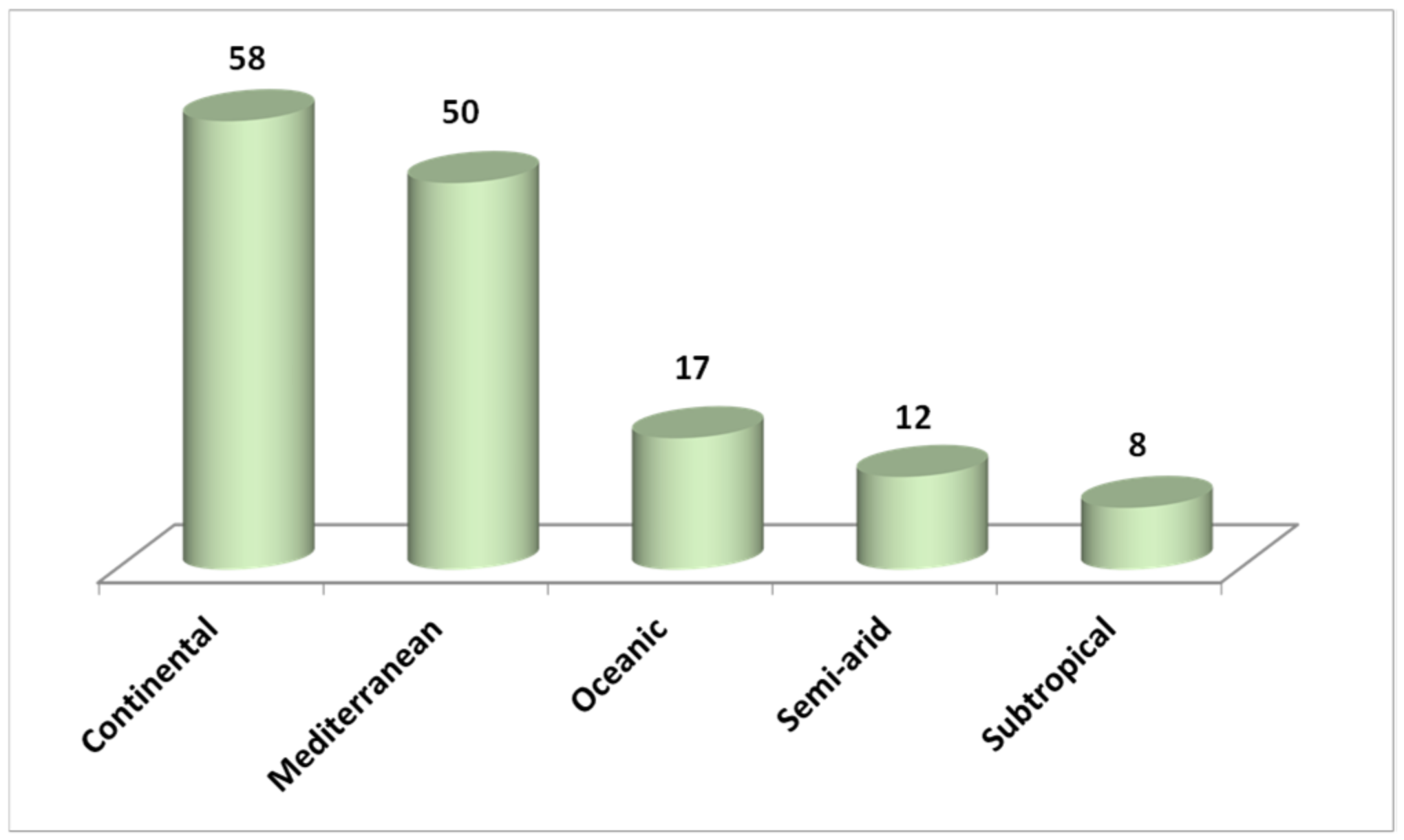







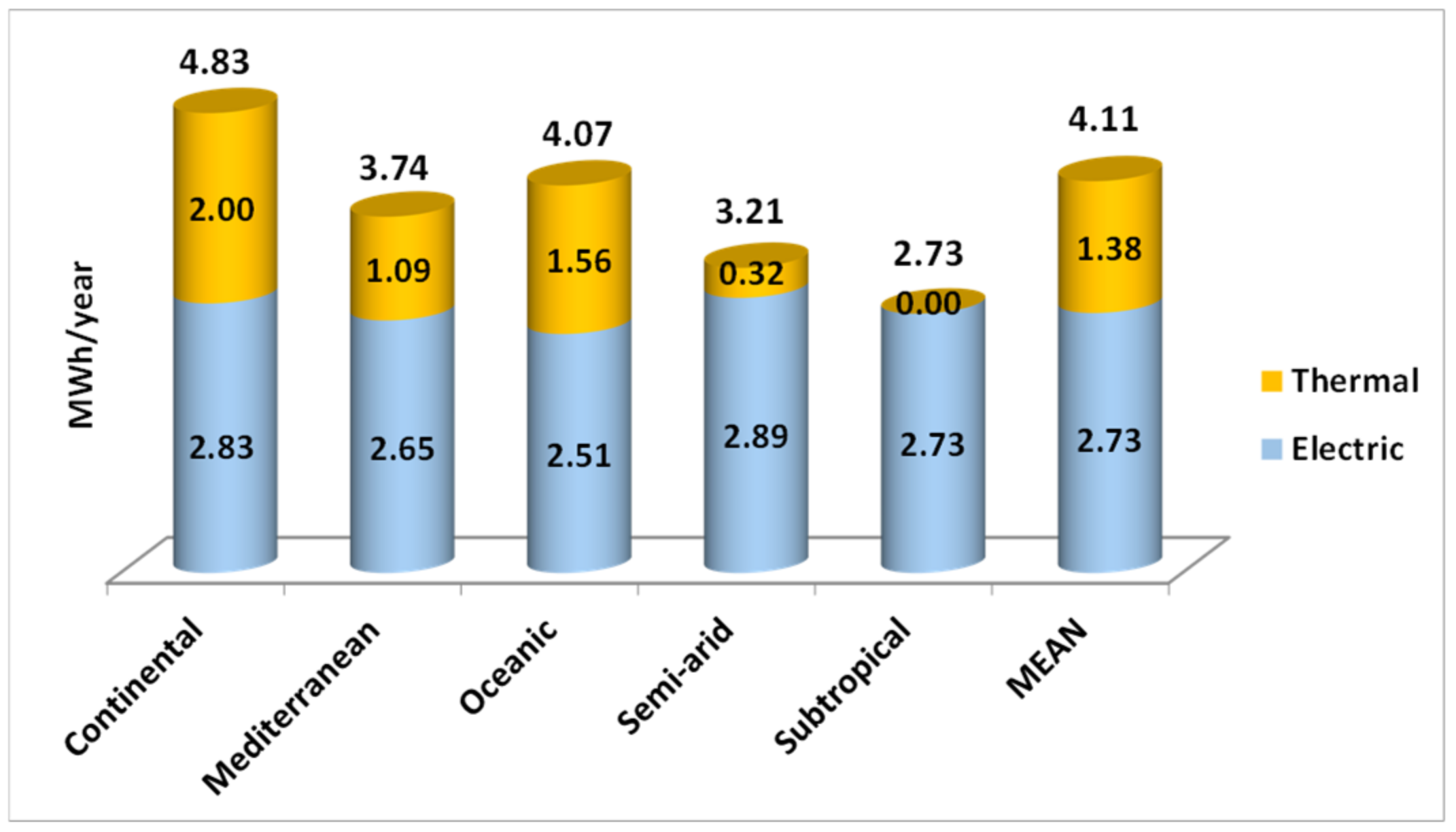
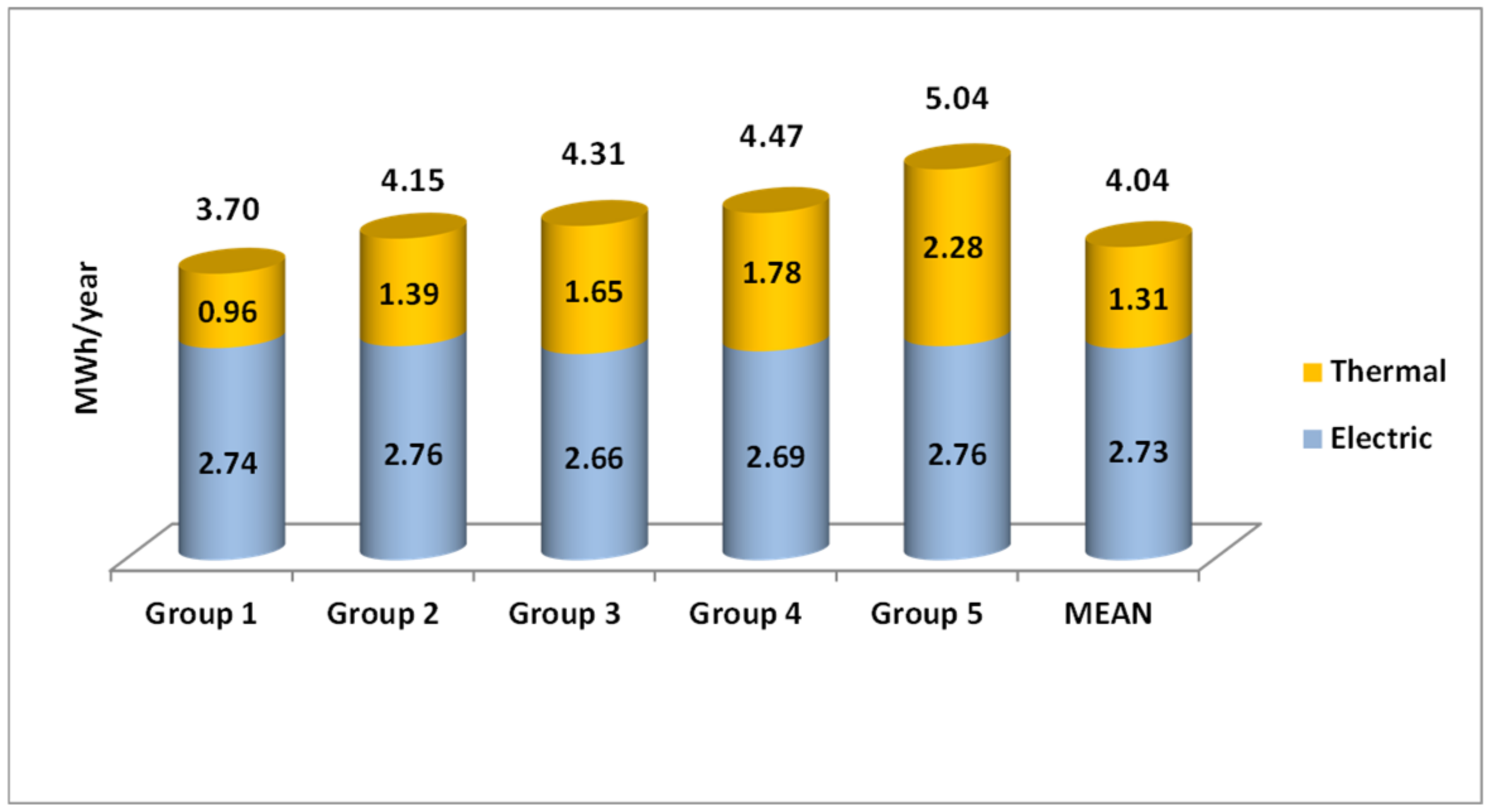


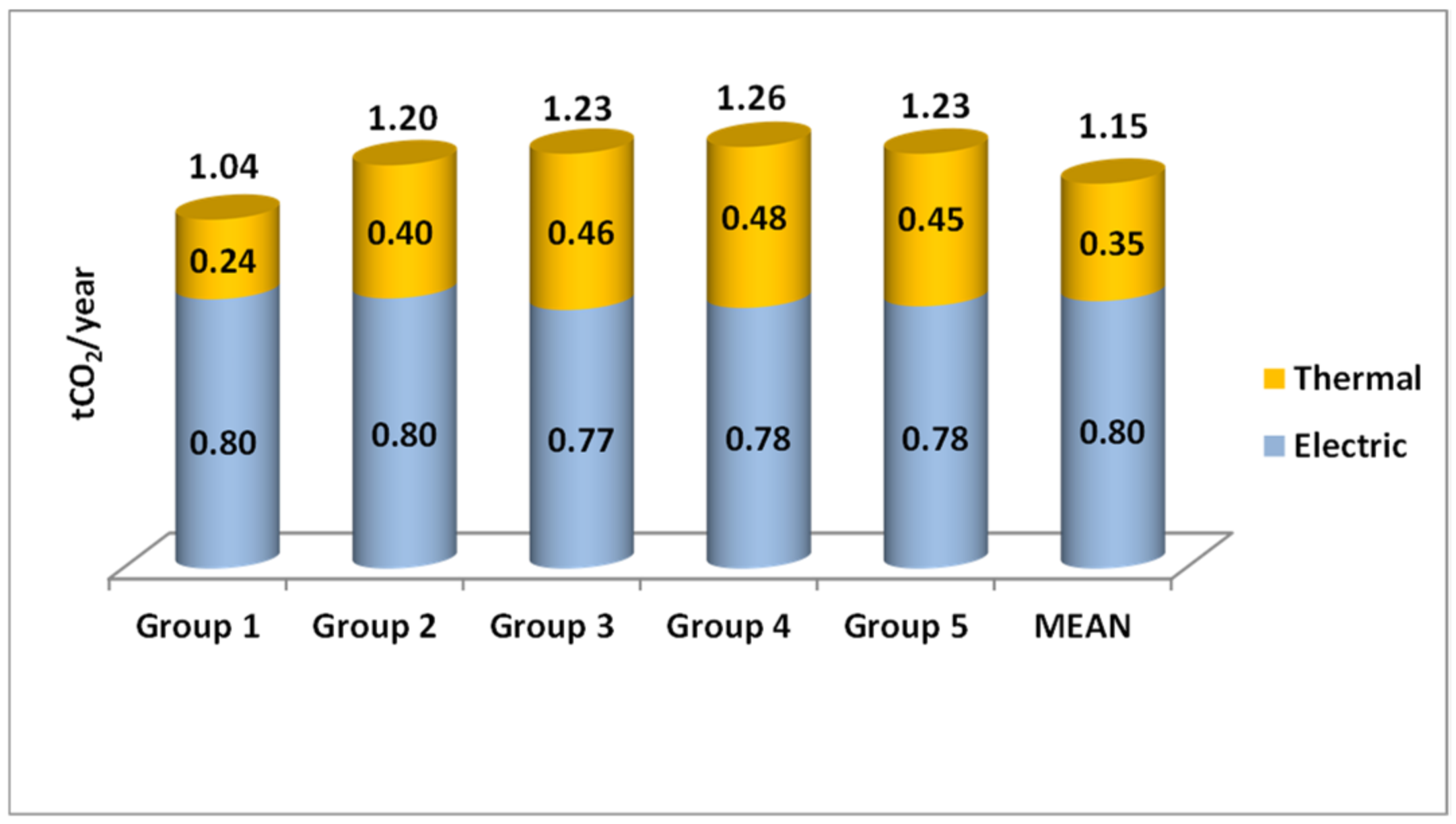
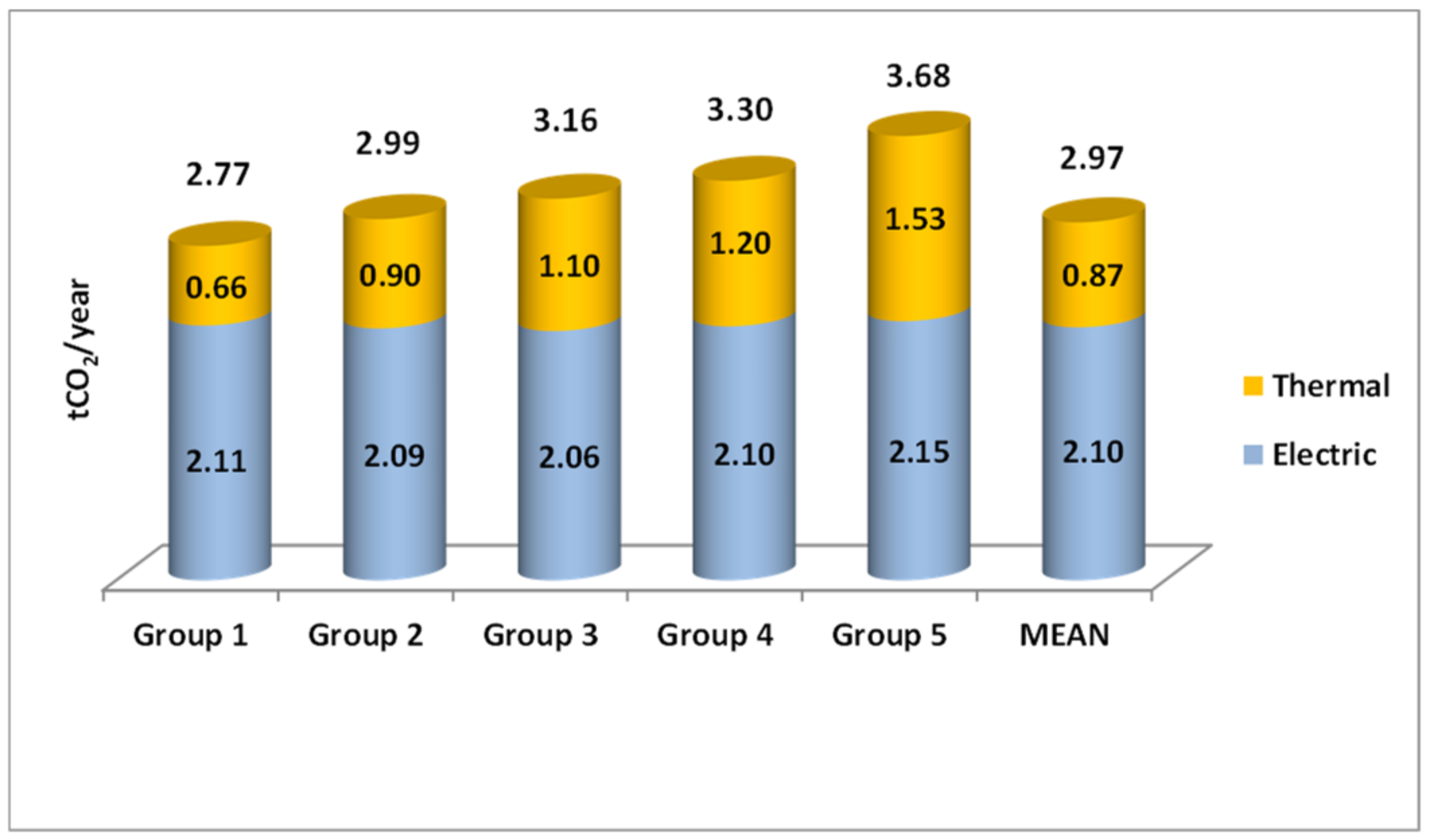
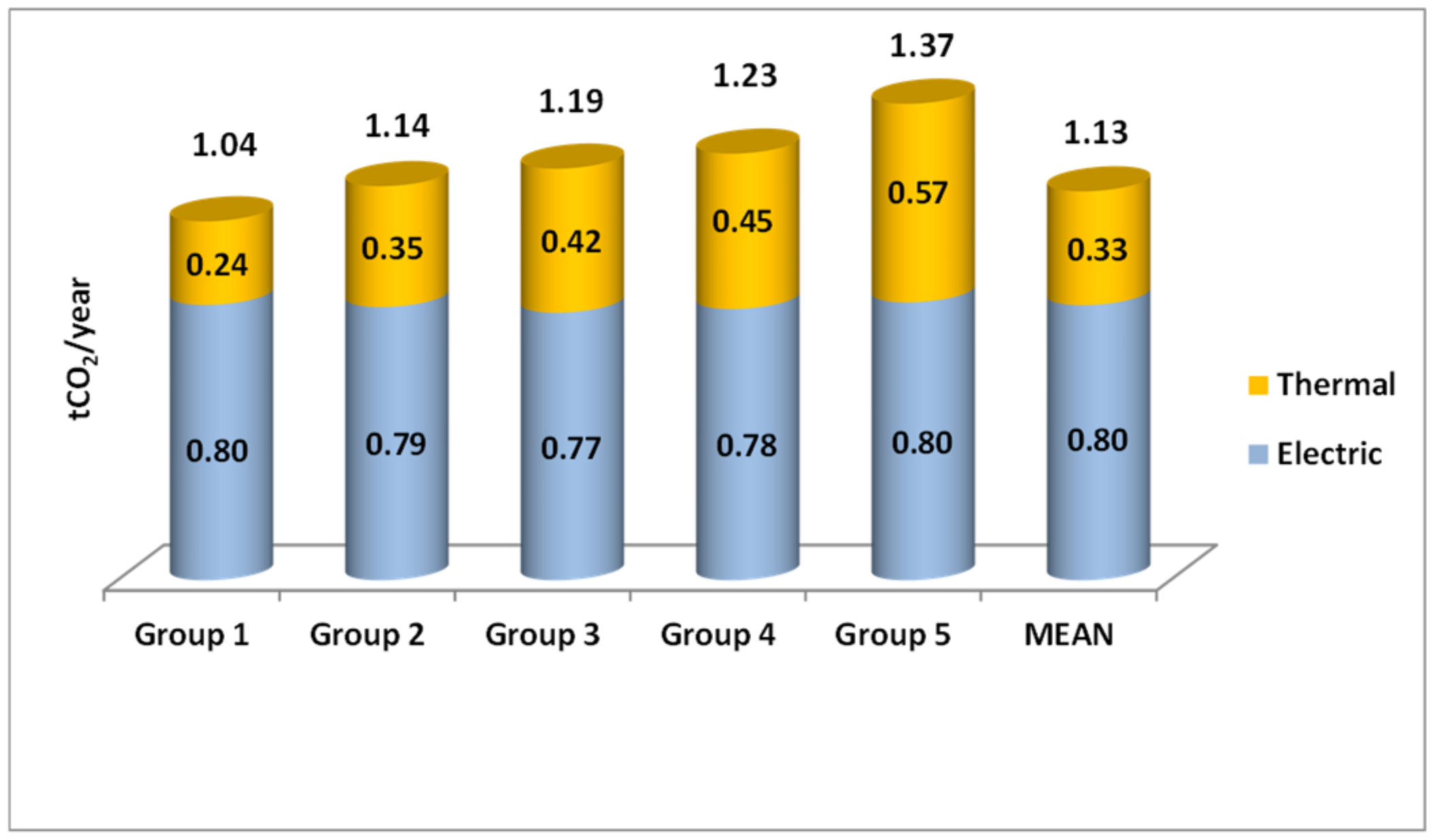
| Inhabitants/Hectare | Cities |
|---|---|
| Group 1: density < 100 | Albacete (C), Alcalá de Guadaíra (C), Alcoy/Alcoi (M), Alicante/Alacant (A), Aranjuez (C), Arganda del Rey (C), Arona (S), Ávila (C), Badajoz (C), Benalmádena (M), Benidorm (M), Boadilla del Monte (C), Cáceres (C), Cartagena (A), Castellón de la Plana (M), Chiclana de la Frontera (M), Ciudad Real (C), Collado Villalba (C), Córdoba (C), Elche/Elx (A), Elda (A), Estepona (M), Ferrol (O), Jerez de la Frontera (M), Linares (C), Línea de la Concepción (La) (M), Lorca (A), Lugo (O), Marbella (M), Mérida (C), Mijas (M), Murcia (A), Orihuela (A), Ourense (C), Paterna (M), Ponferrada (C), Pontevedra (O), Pozuelo de Alarcón (C), Puerto de Santa María (M), Rivas-Vaciamadrid (C), Rozas de Madrid (Las) (C), Rubí (M), Sagunto/Sagunt (M), San Cristóbal de la Laguna (S), San Sebastián de los Reyes (C), San Vicente del Raspeig (C), Sanlúcar de Barrameda (M), Sant Cugat del Vallès (M), Santiago de Compostela (O), Talavera de la Reina (C), Toledo (C), Torrelavega (O), Torrevieja (A), Utrera (C), Vélez-Málaga (C), Vigo (O), Vila-Real (M) |
| Group 2: 100 ≤ density < 200 | Alcobendas (C), Algeciras (M), Almería (A), Arrecife (S), Avilés (O), Burgos (C), Castelldefels (M), Cerdanyola del Vallès (M), Coslada (C), Cuenca (C), Dos Hermanas (C), Ejido (El) (A), Fuengirola (M), Gandía (M), Getxo (O), Gijón (O), Girona (C), Granada (C), Granollers (M), Guadalajara (C), Huesca (C), Irún (O), Jaén (C), Las Palmas (S), León (C), Lleida (C), Logroño (C), Majadahonda (C), Málaga (M), Manresa (M), Molina de Segura (A), Motril (M), Oviedo (O), Palencia (C), Palma de Mallorca (M), Pinto (C), Reus (M), Roquetas de Mar (A), Salamanca (C), San Bartolomé de Tirajana (S), San Sebastián/Donostia (O), Santa Cruz de Tenerife (S), Santa Lucía de Tirajana (S), Santander (O), Segovia (C), Siero (O), Tarragona (M), Telde (S), Terrassa (M), Torremolinos (M), Valdemoro (C), Valladolid (C), Vilanova i la Geltrú (M), Vitoria/Gasteiz (C), Zamora (C), Zaragoza (C) |
| Group 3: 200 ≤ density < 300 | A Coruña (O), Alcalá de Henares (C), Alcorcón (C), Barakaldo (O), Ceuta (M), Getafe (C), Leganés (C), Madrid (C), Mataró (M), Melilla (M), Mollet del Vallès (M), Móstoles (C), Pamplona/Iruña (C), Sabadell (M), San Fernando (M), Sant Boi de Llobregat (M), Sevilla (C), Valencia (M), Viladecans (M) |
| Group 4: 300 ≤ density < 400 | Badalona (M), Barcelona (M), Bilbao (O), Cádiz (M), Fuenlabrada (C), Huelva (M), Parla (C), Prat de Llobregat (El) (M), Torrejón de Ardoz (C) |
| Group 5: 400 ≤ density | Cornellà de Llobregat (M), L’Hospitalet de Llobregat (M), Santa Coloma de Gramenet (M), Torrent (M) |
| Inhabitants per Household | |
|---|---|
| Group 1 | 2.66 |
| Group 2 | 2.59 |
| Group 3 | 2.69 |
| Group 4 | 2.67 |
| Group 5 | 2.68 |
| Total (MWh/Year) | Thermal (MWh/Year) | Electric (MWh/Year) | |||||||||||||
|---|---|---|---|---|---|---|---|---|---|---|---|---|---|---|---|
| Population Density | Mean | Std. Dev. | Median | Max. | Min. | Mean | Std. Dev. | Median | Max. | Min. | Mean | Std. Dev. | Median | Max. | Min. |
| Group 1 | 9.86 | 2.80 | 9.30 | 15.77 | 5.87 | 2.61 | 2.11 | 2.02 | 8.09 | 0.00 | 7.25 | 0.98 | 7.21 | 9.73 | 5.40 |
| Group 2 | 11.06 | 2.30 | 11.73 | 15.46 | 5.78 | 3.59 | 2.29 | 4.14 | 7.33 | 0.00 | 7.17 | 0.99 | 7.08 | 9.52 | 5.40 |
| Group 3 | 11.44 | 2.97 | 12.80 | 14.56 | 5.87 | 4.35 | 2.61 | 5.06 | 7.47 | 0.00 | 7.09 | 0.67 | 7.30 | 8.25 | 5.82 |
| Group 4 | 12.01 | 2.94 | 13.86 | 14.49 | 6.87 | 4.78 | 2.52 | 5.63 | 7.17 | 0.58 | 7.23 | 0.87 | 7.22 | 8.43 | 5.97 |
| Group 5 | 13.46 | 1.70 | 13.77 | 14.40 | 10.64 | 6.08 | 2.18 | 7.06 | 7.39 | 2.81 | 7.37 | 0.26 | 7.34 | 7.68 | 7.14 |
| Total (MWh/Year) | Thermal (MWh/Year) | Electric (MWh/Year) | |||||||||||||
|---|---|---|---|---|---|---|---|---|---|---|---|---|---|---|---|
| Population Density | Mean | Std. Dev. | Median | Max. | Min. | Mean | Std. Dev. | Median | Max. | Min. | Mean | Std. Dev. | Median | Max. | Min. |
| Group 1 | 3.69 | 0.89 | 3.66 | 5.26 | 2.27 | 0.96 | 0.73 | 0.79 | 2.69 | 0.00 | 2.74 | 0.32 | 2.81 | 3.68 | 2.18 |
| Group 2 | 4.15 | 0.82 | 4.40 | 5.51 | 2.27 | 1.39 | 0.88 | 1.62 | 2.69 | 0.00 | 2.76 | 0.31 | 2.74 | 3.72 | 2.25 |
| Group 3 | 4.31 | 1.21 | 4.92 | 5.41 | 1.84 | 1.65 | 0.98 | 1.94 | 2.69 | 0.00 | 2.66 | 0.36 | 2.74 | 3.18 | 1.72 |
| Group 4 | 4.48 | 1.02 | 4.92 | 5.26 | 2.67 | 1.78 | 0.96 | 1.94 | 2.69 | 0.22 | 2.69 | 0.18 | 2.74 | 2.86 | 2.32 |
| Group 5 | 5.04 | 0.67 | 5.26 | 5.26 | 3.91 | 2.28 | 0.83 | 2.69 | 2.69 | 1.03 | 2.76 | 0.04 | 2.74 | 2.83 | 2.74 |
Publisher’s Note: MDPI stays neutral with regard to jurisdictional claims in published maps and institutional affiliations. |
© 2021 by the authors. Licensee MDPI, Basel, Switzerland. This article is an open access article distributed under the terms and conditions of the Creative Commons Attribution (CC BY) license (https://creativecommons.org/licenses/by/4.0/).
Share and Cite
Zarco-Periñán, P.J.; Zarco-Soto, I.M.; Zarco-Soto, F.J. Influence of Population Density on CO2 Emissions Eliminating the Influence of Climate. Atmosphere 2021, 12, 1193. https://doi.org/10.3390/atmos12091193
Zarco-Periñán PJ, Zarco-Soto IM, Zarco-Soto FJ. Influence of Population Density on CO2 Emissions Eliminating the Influence of Climate. Atmosphere. 2021; 12(9):1193. https://doi.org/10.3390/atmos12091193
Chicago/Turabian StyleZarco-Periñán, Pedro J., Irene M. Zarco-Soto, and Fco. Javier Zarco-Soto. 2021. "Influence of Population Density on CO2 Emissions Eliminating the Influence of Climate" Atmosphere 12, no. 9: 1193. https://doi.org/10.3390/atmos12091193
APA StyleZarco-Periñán, P. J., Zarco-Soto, I. M., & Zarco-Soto, F. J. (2021). Influence of Population Density on CO2 Emissions Eliminating the Influence of Climate. Atmosphere, 12(9), 1193. https://doi.org/10.3390/atmos12091193






